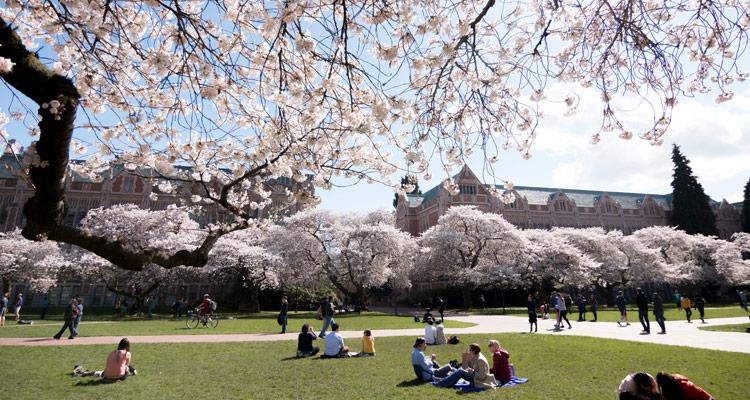The University of Washington was established on a 10-acre tract of land in what is now downtown Seattle in 1861. For many years the size of the grounds was enough to contain the small population of students and professors. However, as the UW grew in the 1880s it became apparent that the original site, then surrounded on all sides by increasing urban development, would be insufficient for continued growth.
In 1893, the tireless efforts of Edmund Meany, himself a UW graduate and then a member of the state legislature, convinced the state to purchase 583 acres of forestland adjacent to Lake Washington and Portage Bay for a new campus. In 1895 the University moved to its present site when the first building, Denny Hall, was completed. As a rationale for acquiring so much land, and because he believed in the benefits of having a living laboratory for horticulture and forestry as part of the campus, the new University site was designated as the “Grounds and Arboretum.” Meany, who later taught at the University for 35 years, is often referred to as “The Father of the University.” For many years he led students and UW gardeners in planting trees on campus and acquiring plants from around the world. And the grounds, though selectively logged prior to 1895, still contained a great variety of native plants in the largely forested site.
During the first decade at the new site, the buildings and activities were centered around the north part of campus. The first attempt at comprehensive campus planning was made in 1904 when the University Regents hired the Olmsted Brothers firm, internationally renowned landscape architects, to guide future development. They laid out a rather traditional grid plan of buildings connected by walkways and plazas that referenced earlier campus developments around Denny Hall. However with the decision by the University and City of Seattle to hold the 1909 World’s Fair on campus, a new plan was developed. This time the Olmsted Brothers developed a completely new vision for the campus, centered on a dramatic central vista to Mt. Rainier as well as prominent views to Lake Washington and Portage Bay.
This plan, which was fully realized for the opening of the “Alaska Yukon Pacific Exhibition” (AYPE) in June of 1909, shaped the character and layout of campus grounds that continues to the present day. The site containing the Sylvan Grove is the successor of an outdoor theater building that was constructed in a forest clearing for the AYPE. Many of the trees now lining Rainier Vista were seedlings at the time of the fair. Over 100 gardeners were hired to plant, tend and care for the acres of gardens that surrounded the dozens of temporary (and 4 permanent) buildings that were constructed for the fair. It was a massive undertaking, and the beauty of the grounds led the press of the day to call it the most beautiful fair in American history.
Following the hugely successful Alaska Yukon Pacific Exhibition, the Regents commissioned another plan in 1915 that built off of the Olmsteds’ 1909 plan. The plan was developed by Carl Gould, who would later found the University’s Department of Architecture, and it guided development of the campus and grounds for the next 30 years. The University grew rapidly, and this led to increased pressures for building space. Most of the original Arboretum plantings were lost to development or moved. It is believed that only one of the trees that Meany planted, a giant sequoia near Smith Hall, survives to the present day. However, the legacy continues in the practice of planting a variety of trees from all over the world. Biology, Landscape Architecture and Forestry students continue to use campus as an outdoor classroom.
Many of the most beloved campus landscapes were created in more recent times. The ceremonial entrance to campus, Memorial Way, is flanked by giant London plane trees planted in the early 1920’s in memory of those UW students and staff killed in World War I. The buildings that make up the Liberal Arts Quad were completed in the early 1930s, but it wasn’t until almost 30 years later that the iconic flowering cherries were planted. These were transplants from the Arboretum that were in the path of the new State Route 520 highway south of the campus.
The former Montlake Landfill, at the east edge of campus, was capped in the late 1960s after many decades of use, and much of it is now a vast open space containing University athletic and intramural fields and the Union Bay Natural Area (UBNA). For the past 30 years the UBNA has been used as a living laboratory for ecological restoration, with programs and research conducted by the UW Botanic Gardens staff and students. Today it is considered the best urban bird watching area in the state. In the early 1990s the Grieg Garden was developed between Suzzallo Library, the Quad and the Husky Union Building. All of these features combine with the natural beauty of site to create one of the most scenic campuses in the world.
